Frequently Asked Questions
- About the Audioguide
- Why use this audioguide?
- How do I use this audioguide?
- Visiting Palomar Observatory
- What are the opening hours?
- Is it open on holidays?
- Is there an admission fee?
- Can I reserve Hale Telescope tour spots in advance?
- Are you offering private tours?
- Are the Hale Telescope tours wheelchair-friendly?
- Are children allowed on Hale Telescope guided tours?
- Can I come with my children? They love astronomy.
- Is Palomar Observatory child-friendly?
- Is there a café or restaurant at the observatory?
- Is it unwise to visit on a cloudy/rainy day?
- Can I come to Palomar tonight to see the eclipse/meteor shower/astronomical event?
- Are there any nighttime tours?
- Are there any nighttime star parties?
- Is it possible to visit at night without getting kicked out for trespassing?
- Can I look through any of the Palomar telescopes?
- Is there another telescope besides the Hale open for visitors?
- Is it possible to interact with the telescope personnel/Observatory staff?
- Academic/Operations Questions
- What are the most important scientific discoveries made at Palomar? The most recent?
- Are the Palomar telescopes still being used for science? How often?
- The Hale Telescope is no longer the largest optical telescope in the world. Why do we still need it?
- What is the primary optical element (mirror or lens) of the Hale Telescope and where is it?
- How does the 200-inch mirror compare to other large telescope mirrors?
- What is the focal ratio of the Hale Telescope?
- Where do you look through the Hale Telescope?
- What is the coating on the mirror? How often is it replaced?
- How far can the Hale Telescope see?
- How much of the sky can the Hale Telescope see?
- Are you having trouble with light pollution?
- Is the Hale Telescope used for astronomy during the day?
- Can the Hale Telescope be used remotely?
- What is a CCD? Can you see the image right away on a screen?
- How does the Hale Telescope move?
- Has the Hale Telescope ever moved as a result of an earthquake?
- How long does it take for the dome to make one complete rotation?
- What’s the inside surface of the dome made of?
- What is adaptive optics? Is it used at Palomar?
- What are the other telescopes at Palomar used for?
- How does one apply for telescope time?
- What is the Hartmann screen?
- Joining/Supporting Palomar
- How do I become a Palomar Docent? What are the benefits?
- How do I become a Friend of Palomar Observatory? What are the benefits?
- Be invited to special tours, star parties, and events at the observatory and partner institutions, as well as special presentations given by Palomar astronomers;
- Receive The Big Eye, a newsletter about the current research, history, and educational outreach mission of Palomar Observatory;
- Earn a 20% discount on purchases from the Palomar Observatory Gift Shop; and
- Support the educational mission of the observatory, including new exhibits and displays for all of the observatory's visitors.
- I’d like to work at Palomar. Do you list job openings?
- Other General Questions
- Is Palomar Observatory publicly owned?
- How much land does the observatory own?
- Why did Caltech select this site in 1934?
- What’s the elevation of the observatory?
- Does Palomar have an online store?
- I'd like to read more about Palomar Observatory. Are there books dedicated to this topic?
- Florence, R. (1994) The Perfect Machine: Building the Palomar Telescope, New York: HarperCollins Publishers. Florence delves deep into scientific motivations and engineering challenges of making the largest and most precise scientific instrument in the world. Also of note is the 2008 PBS documentary inspired by this book: Journey to Palomar.
- Porter, R. (1983) Giants of Palomar, Pasadena: California Institute of Technology. A revised printing of the 1947 edition titled The Photographic Giants of Palomar, this short book showcases Russell W. Porter's superb drawings and sketches of the Hale Telescope and many of its components, along with context contributed by Palomar Observatory staff.
- Preston, R. (1987) First Light: The Search for the Edge of the Universe, New York: Random House. The subjects in Preston's book are not the Palomar telescopes but the astronomers who used them. Their motivations, thought processes, and ultimate genius in pursuing great unknowns make First Light a very enjoyable and even relatable collection of stories.
- Schweizer, L. (2020) Cosmic Odyssey: How Intrepid Astronomers at Palomar Observatory Changed Our View of the Universe, Cambridge, MA: the MIT Press. Schweizer explains the great many scientific achievements of Palomar Observatory, and places them into context as cornerstones to our current understanding of the cosmos.
- Woodbury, D. (1940) The Glass Giant of Palomar, New York: Dodd, Mead & Co. Woodbury documented much of the observatory's design process and engineering challenges as they were happening, as he spent time with Caltech scientists and engineers just prior work interruption during World War II.
- Wright, H. (1952) Palomar, the World's Largest Telescope, New York: MacMillan Co. In her book, also published under the title The Great Palomar Telescope in the UK, Wright completes the observatory building story left unfinished by Woodbury. Includes a preface by I. S. Bowen, Director of Mt. Wilson and Palomar Observatories.
- Do you have a webcam to show what the telescope is currently looking at?
- What’s that bright light in the sky? and other general astronomy questions.
We recommend using our free audioguide if you visit Palomar Observatory during the winter months when there are no docent-led tours available, or to get most out of your visit. The audioguide (aka self-guided tour) is a collection of media and information that explores individual topics about Palomar Observatory. The primary purpose of the audioguide is to serve video commentaries on significant stops during your visit (tip: these videos can also be viewed on a large TV screen at the Visitor Center/Museum's Luskin media kiosk). We plan on expanding the initial audioguide content with additional media in the near future.
OPEN AUDIO TOPICSOther sections of the audioguide include a virtual tour (which shows other telescopes and observatory areas not open to the public), relevant information on docent tours or other public events, an interactive map, and links to the Palomar Observatory website.
Instructions on how to use this audioguide can be found under the button (top right).
OPEN INSTRUCTIONSOr watch the mini tutorial available from the home page.
LAUNCH MINI TUTORIALMost days the observatory is open to the public from 9:00 am to 3:30 pm. Please see our Visiting Palomar page for details and exceptions.
VISITING PALOMARWith some exceptions, Palomar Observatory is open to the public daily. These exceptions are Caltech institutional holidays (e.g., Juneteenth, 4th of July, Thanksgiving, December 23 through January 1), certain maintenance operations, and possible weather emergencies. However, we strongly advise checking our homepage for closure messages on the day you plan on making the long drive to the observatory. More information on the Visiting Palomar page.
VISITING PALOMARThere is no admission fee for visiting Palomar Observatory. However there is a nominal charge for our weekend guided tours of the Hale Telescope. Please see the Palomar Tours page for details.
GUIDED TOURSNo—tour tickets are limited-availability and sold exclusively on a day-of and first-come, first served basis. Please plan accordingly.
Palomar Observatory tour information is summarized Tours page.
GUIDED TOURSThe Hale Telescope dome is a prominent expression of 1930s Art Deco architecture. Unfortunately, modern accessibility features were not typically incorporated in buildings of that era.
We welcome mobility-impaired visitors who are not wheelchair-bound and support Hale access for such visitors at 10:45 am and 1:15 pm daily, resources and conditions permitting. Mobility-impaired visitors should check-in with the store attendant (the store is located in the Greenway Visitor Center) to receive specific access instructions, and may discuss any special support needs. We regret that we cannot accommodate wheelchair access to the Hale Telescope dome at this time. More information on our website.
VISITING PALOMARChildren under 5 years of age are not allowed on guided tours.
The observatory welcomes visitors of all ages during public visiting hours. Most of our exhibits and programs are geared toward an adolescent and adult audience, but all are welcome to enjoy the observatory’s hospitality, including viewing the 200-inch Hale Telescope, and the exhibits and informational displays at the observatory museum. With educational enrichment in mind, parents, particularly of younger children, are encouraged to also consider visiting sister organizations like Griffith Observatory and the California Science Center.
Palomar Observatory is primarily a research facility. While it has a museum with some exhibits, these are of an informational nature and young visitors (<12yo) may not find them as engaging as exhibits in a science center. Likewise, the 1-hr long tour presentations (which focus on history, science, and engineering) are unsuited for young children. You are welcome to bring your children and visit at your own pace. If our docents are present, they will be happy to answer astronomy and telescope-related questions from your children in terms they can understand. However, if you are looking for a child-friendly, hands-on science museum experience with telescope viewing, we recommend visiting Griffith Observatory in Los Angeles instead.
No, there is no café or food for sale on the premises. However, there is a picnic area near the parking lot for those who bring their own lunch. Please note that there is a no food or drink policy within the observatory buildings.
Not necessarily, but keep in mind that part of your visit to the observatory will be spent outdoors on foot. Moreover, the drive up and down the mountain is far more pleasant under fair weather and high-visibility conditions.
Palomar Observatory closes promptly at the posted hours (see the opening hours question above).
Palomar Observatory is a research facility focused on astronomical research operations during nighttime hours. Sister organizations like Griffith Observatory, Mt. Wilson Observatory, Lick Observatory, and Lowell Observatory offer public nighttime programs.
A few times a year the Palomar Observatory docents host star parties for our Friends organization just outside the observatory compound at the Outreach Center, where members can look through portable telescopes. If you wish to attend a star party, you can join the Friends of Palomar Observatory or contact one of four local astronomy clubs: San Diego Astronomy Association, Temecula Valley Astronomers, Orange County Astronomers, and Riverside Astronomical Society.
FRIENDS OF PALOMARPalomar Observatory is private property. Please do not enter the observatory compound outside of visiting hours.
Palomar telescopes were not designed for eyepiece viewing in scientific application, and the observatory does not host eyepiece viewing for the public. See also question C.7 below.
No—the other active telescopes at Palomar are used for research as well and are closed to the public. However, the observatory’s first operational telescope, the 18-inch, is on display at the Greenway Visitor Center. In addition, you may use the VR Tour to “virtually visit” locations closed to the public.
LAUNCH VIRTUAL TOUROther than the store staff and the docents (present most weekends between April and October), no. Observatory staff are busy preparing for every night’s observing operations.
Palomar has contributed groundbreaking research and discoveries to many and varied fields in astronomy. Some of the first breakthroughs achieved at Palomar were cosmic distance and expansion measurements (a.k.a. measuring the “size” of the Universe). Hundreds of supernovae were discovered with the Schmidt telescopes. The identification of distinct stellar populations of different age and elemental composition was first done by astronomers using the Hale Telescope. The first quasar, 3C 273, was discovered here, as well as the first undisputed brown dwarf, Gliese 229B. The famous fragmented comet that collided with Jupiter in 1994, Comet Shoemaker-Levy 9, and a number of transneptunian objects, including Eris, that triggered the revision of planet definition and the demotion of Pluto as a planet were also discovered with Palomar telescopes. Please visit our museum in the Greenway Visitor Center for context and discussion on these and other Palomar discoveries.
Today, Palomar Observatory’s survey programs with the Samuel Oschin Telescope are extremely prolific in the discovery of transient events. In recent years they have detected thousands of new supernovae and cosmic explosions, novae and cataclysmic variable stars, flaring young stars, as well as nearby fast-moving asteroids. For up-to-date information on news related to Palomar Observatory, including recent discoveries, please visit our website’s news page.
PALOMAR NEWSYes—Palomar telescopes have been used for science almost continually since 1936 (there were interruptions during the World War II years). This is over a decade prior to the dedication of the Hale Telescope in 1948. Astronomers use Palomar telescopes roughly 300 nights a year (given typical losses to inclement weather, maintenance, and new instrument development). The observatory’s only scheduled holiday closure is on December 24 and 25. The slideshow in the Visitors Gallery inside the Hale dome gives a brief explanation of the research and observations being undertaken on the Hale Telescope during the current week.
The Hale Telescope continues to offer modern instrumentation and provides important "sky access" for astronomers at Palomar partner institutions (Caltech, JPL, Yale University, and NAOC). Even for Caltech astronomers who also have Keck Observatory access Palomar telescopes such as the Hale provide unique and competitive resources that are difficult to duplicate elsewhere.
The Hale Telescope is a reflector, that is, a telescope whose primary optical element is a curved (paraboloid) mirror—there are no lenses in the telescope itself. The Hale primary mirror is 200 inches (5.1 m) in diameter, weighs 14.5 tons, and is made of Pyrex. Its polished surface, covered with a thin layer of aluminum, is concave. The mirror's thickness varies between 19 ⅝ inches (49.8 cm) at the center and 23 ½ inches (59.7 cm) at the outer edge. The mirror, placed at the lower end of the telescope truss, is held by a steel cell and protected by an iris-like cover that opens during observations.
The image below shows the mirror (shiny disk) and steel cell being removed from the telescope for maintenance.
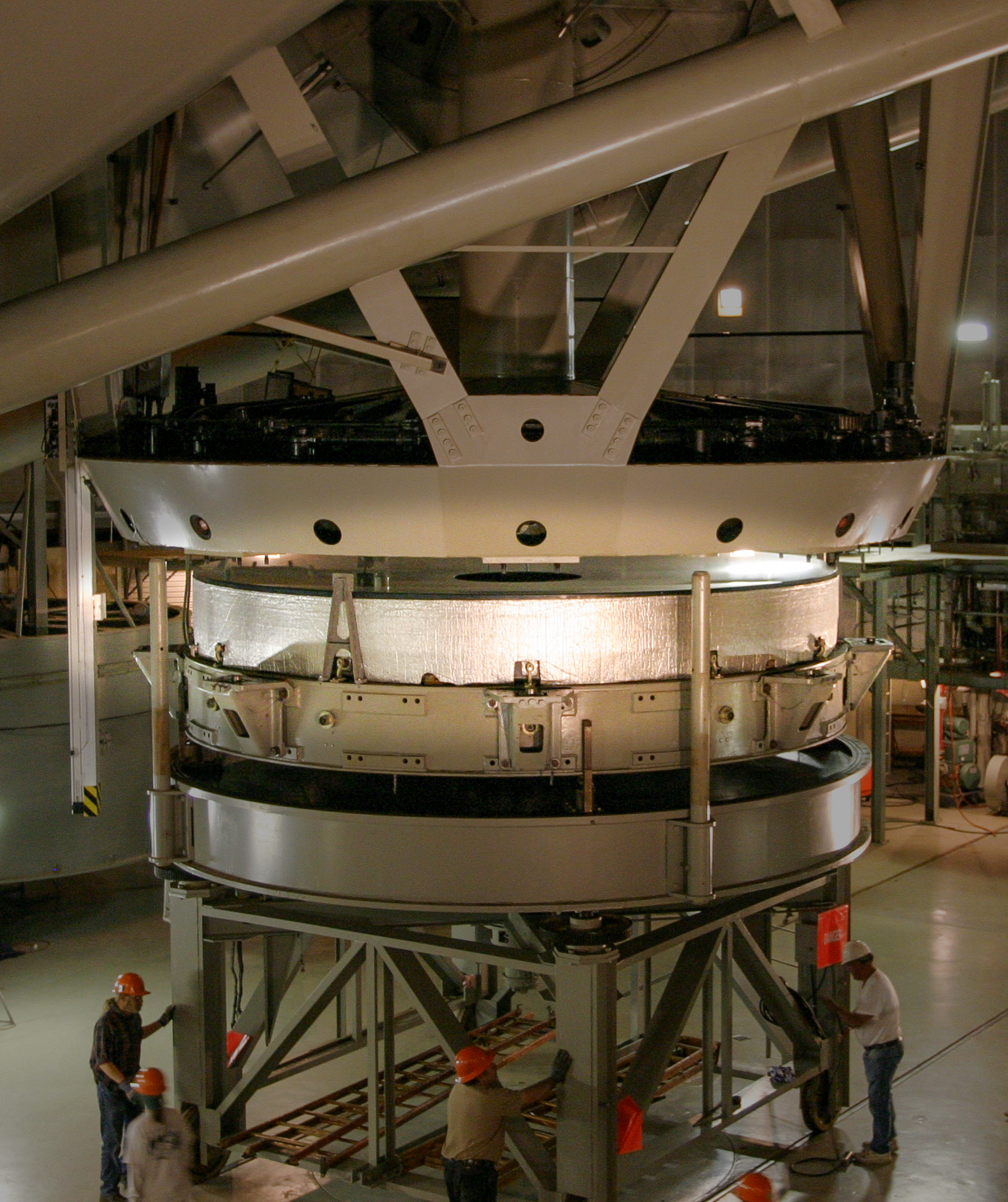
The 200-inch (5.1-m) Hale Telescope was the largest aperture operational telescope in the world for about 45 years until Keck 1 came online in 1993. It was still among the largest monolithic (one-piece mirror) reflectors until the end of the 20th century—both current fabrication technology and road transportation constraints limit single mirrors to being just over 8 m or 26 ft per piece. Larger aperture telescopes use multiple mirrors acting as one.
The following image (adapted from Wikipedia) shows the relative sizes of the primary optical elements (a couple lenses, mostly mirrors) of the largest telescopes in the world. The 200-inch mirror is near the top left corner.

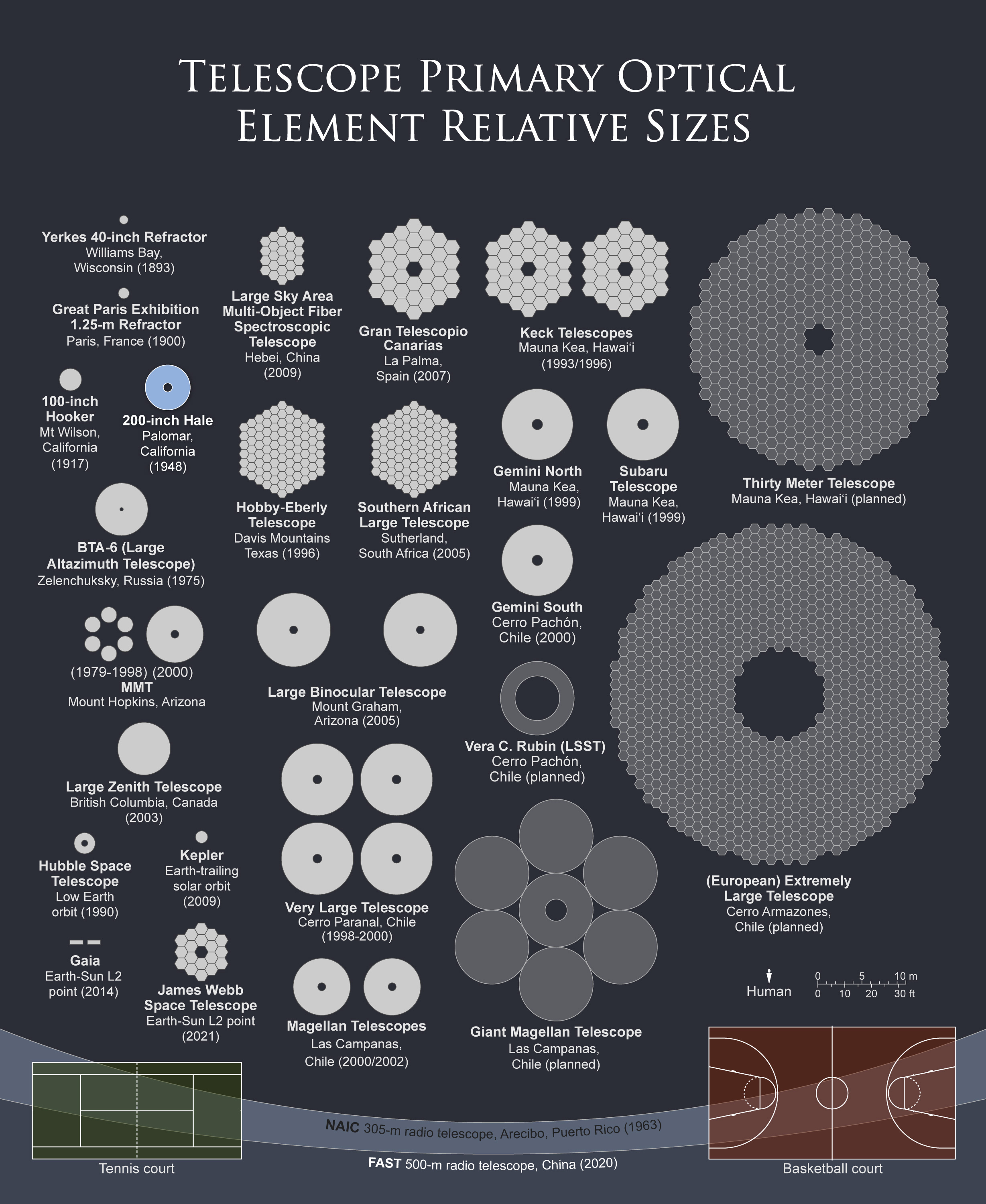
Because the mirror is a paraboloid (f/3.3, focal length 660 inches or 16.76 meters), light comes to a focus near the top of the telescope at what is known as the prime focus. A camera or scientific instrument can be placed at prime focus, or a secondary mirror to reflect the light back down through a hole in the primary mirror to what is known as the Cassegrain focus (f/16, focal length 3,200 inches or 81.3 meters). Two additional light paths are also possible—by using additional mirrors, light can be directed into the coudé focus (f/30, focal length 6,000 inches or 152 meters) or to an instrument in the east arm of the telescope. Cassegrain focus commonly operates at f/9 through the use of a corrector lens.
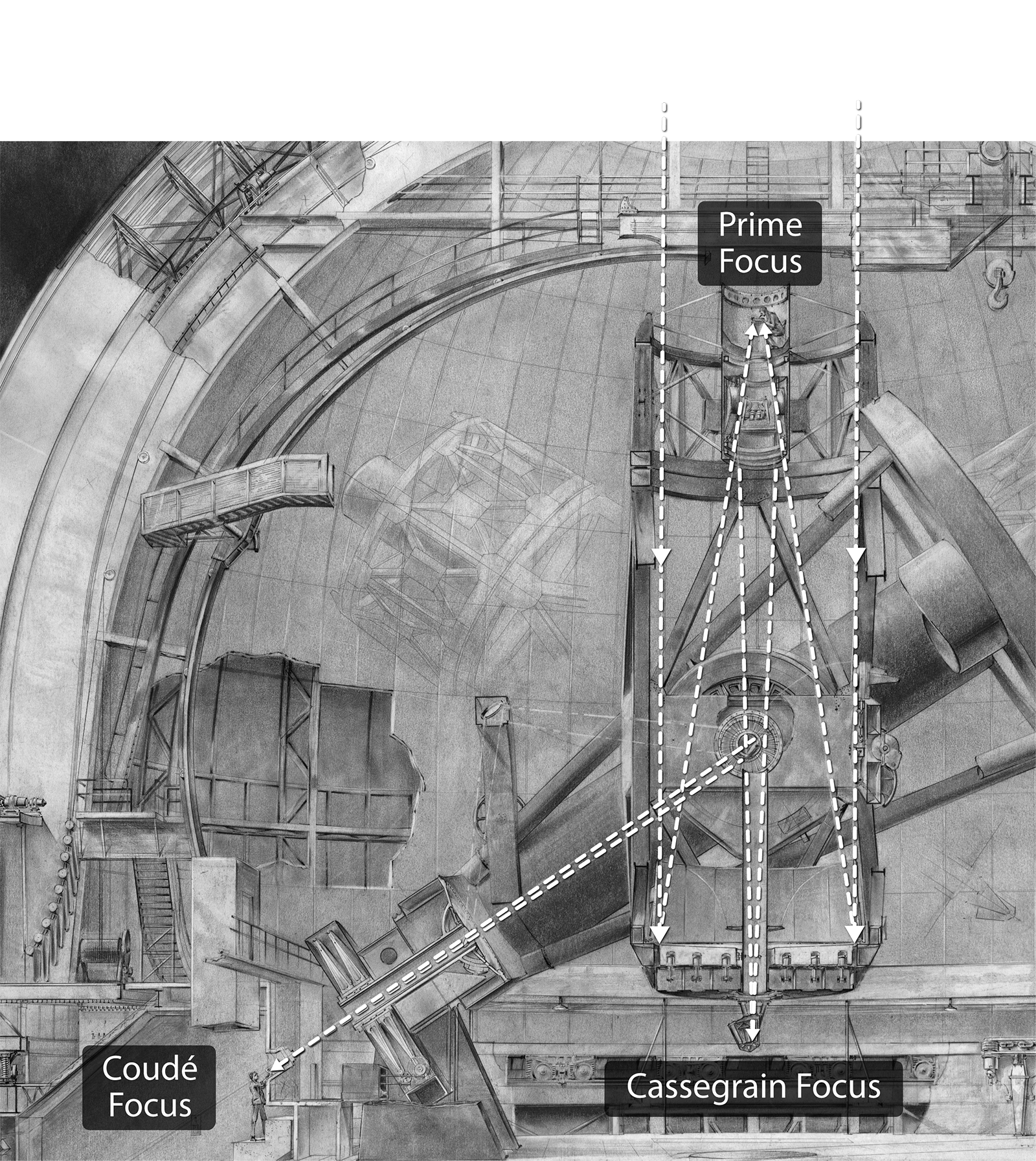
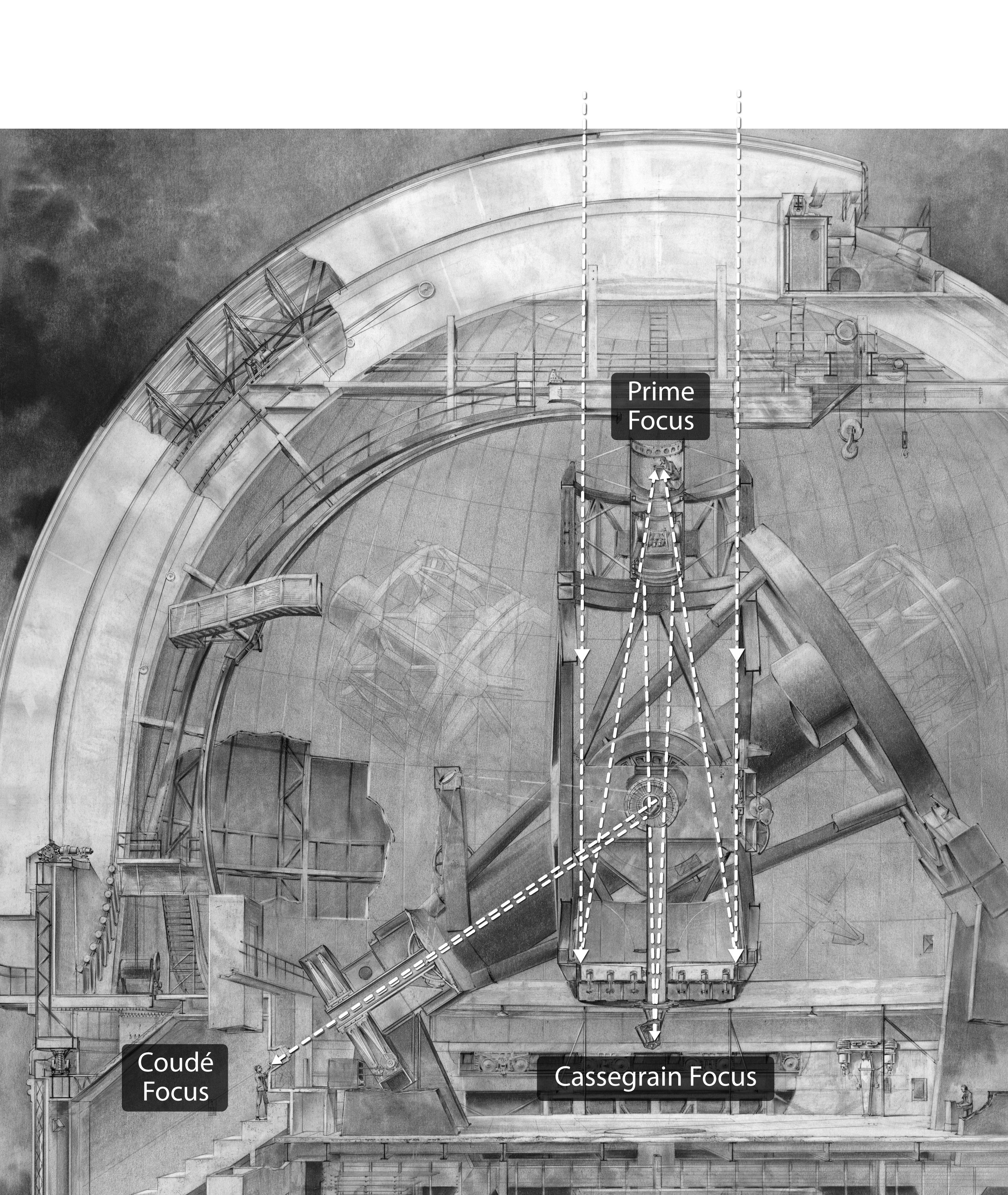
The Hale Telescope was designed and built so that astronomers could “ride” the telescope and image their target objects from the prime and Cassegrain focus cages. There was a third observation point at the coudé focus in a room near the south end of the telescope. Looking through the Hale was possible at these three locations, though research was done by light-collecting instruments such as photographic cameras and spectrographs, not by eye. Riding the Hale Telescope became less of a necessity with the development of modern electronics and CCD technology in the late 1970s and early 1980s. Since the early 1990s, all incoming light is collected by electronic instruments placed at the telescope foci while astronomers observe from a nearby computer room.
The mirror’s coating is aluminum, about 3 to 4 millionths of an inch (75 to 100 nm) thick. That requires only about 1/6 ounces (5 grams) of aluminum. Aluminum reflects about 90% of incident visible light.
Every night when the dome shutters open, the telescope and mirror are exposed to the sky. Over time dust, leaves and even bird or bat droppings may make the mirror surface dirty. The mirror is cleaned and recoated on average every 18 to 24 months and the entire process takes about a week. The video above shows the recoating process (turn on CC for commentary).
This question is not easily answered. A more careful way to ask this question is, how faint can the Hale Telescope see? Astronomers describe brightness in units called magnitude, which counterintuitively increases as the source gets fainter. An intrinsically bright faraway object like a quasar at apparent magnitude 13 is easily observed with the Hale, while a nearby small and intrinsically faint asteroid at apparent magnitude 25 may not be detectable depending on conditions.
From Earth, the brightest Venus can appear is magnitude −3. The well-known stars Arcturus, Vega, and α Centauri A all have magnitudes of near 0. The average observer looking at the night sky under very good conditions and away from urban areas can see stars as faint as magnitude 6.5.
In hours of exposure under ideal conditions, the Hale Telescope has observed objects as faint as magnitude 25—4 trillion times fainter than what the average human can see with the unaided eye. For comparison, the Hubble Space Telescope’s faintest observed object has magnitude 31.5 as measured in the eXtreme Deep Field (XDF) in weeks of exposure time.
At any one time and with current instruments at prime focus, the Hale Telescope has a field of view of approximately 18.5 arcminutes on the side. This is about 50% the area (solid angle) of the full moon.
That said, the portion of the sky accessible to the Palomar telescopes over the course of the year is the whole northern celestial hemisphere and the equatorial regions all the way down to -33° in declination.
The image below shows a comparison between the fields of view of the Hale Telescope, the Samuel Oschin Telescope, and the Hubble Space Telescope, if they were all looking at the Orion Nebula.
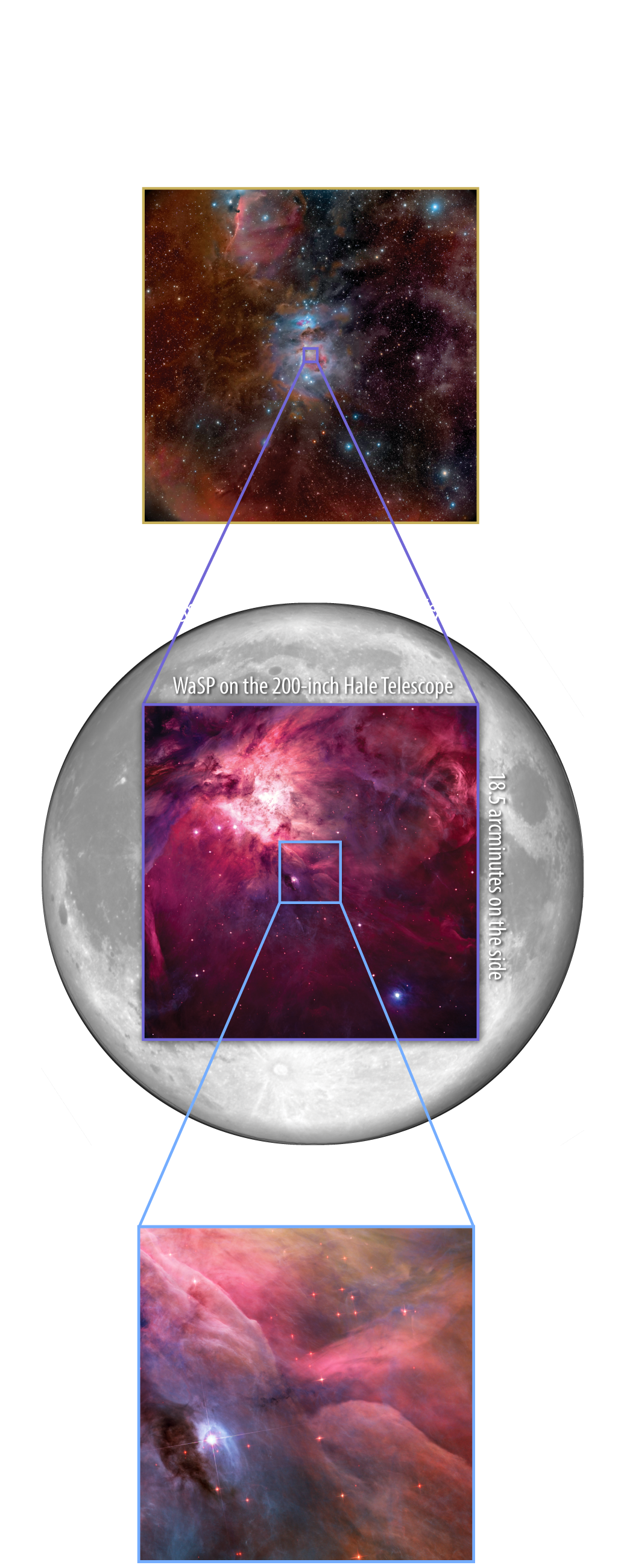
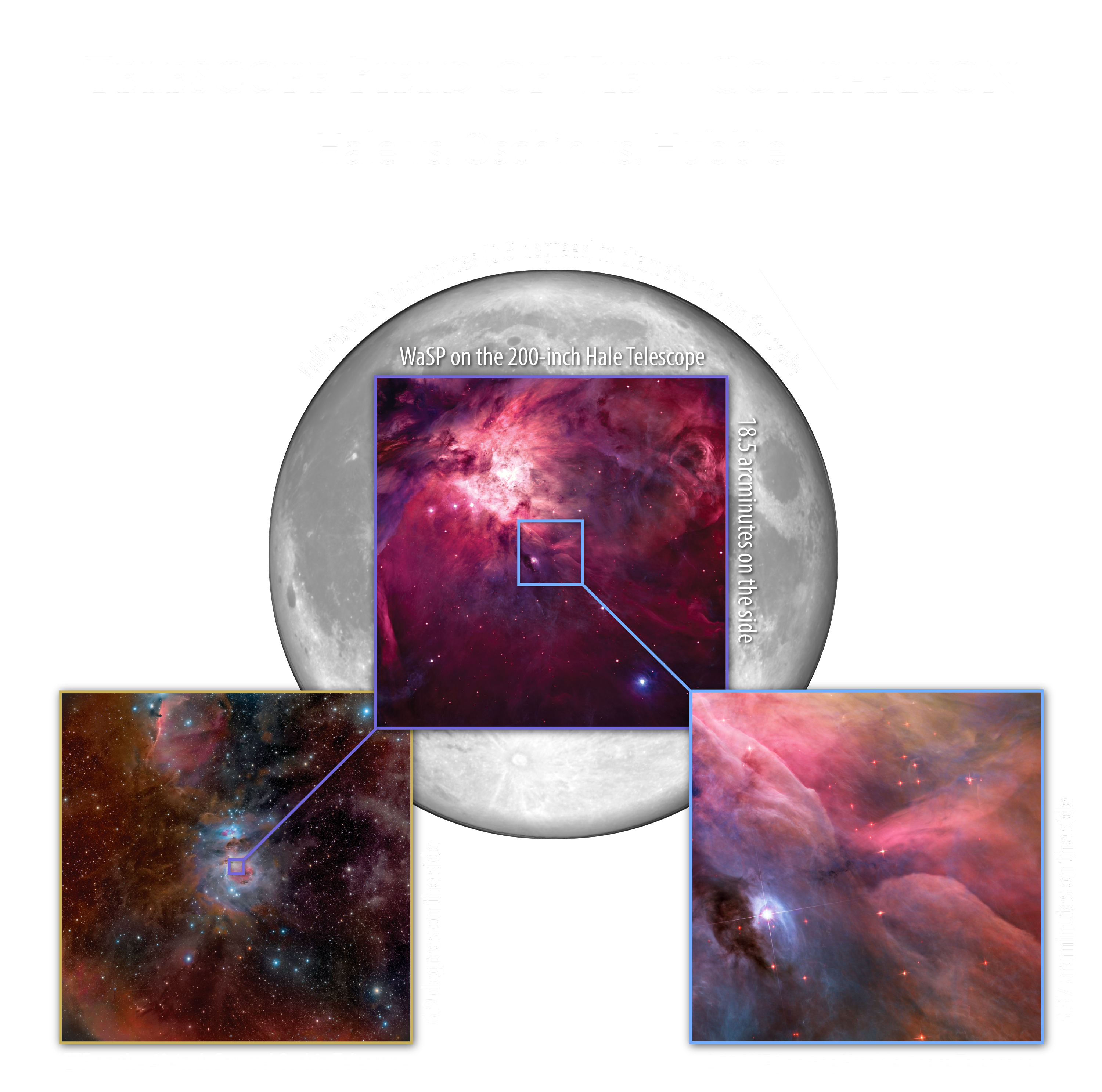

Yes—the horizons are getting brighter and brighter every month. But, within 45° of the zenith, the sky is still in relatively good condition. Also, we have been emphasizing studies that examine the sky at near-infrared wavelengths where light pollution is not a problem. Visit this page for more on light pollution.
LIGHT POLLUTIONNo, the Hale Telescope operates only during nighttime hours.
Yes—since 2010 astronomers have had the option of conducting their observations remotely from the Caltech campus in Pasadena CA while the telescope is operated locally by Palomar staff. Most partner research institutions also have suitable remote observing facilities on their campuses.
A charge-coupled device (CCD) is a silicon-based semiconductor light detector. CCDs were first used in optical astronomy in the 1970s, and since the 1980s they have largely replaced older photographic methods in professional astronomy due to their far superior light detection efficiency. Today, similar CMOS detectors can be found in most modern cameras, computers, or smart portable devices, and are commonly described by their size in pixels count. At Palomar, the largest CCD detector system is installed on the Samuel Oschin Telescope. It has sixteen 6k × 6k pixel CCDs—that is 576 million pixels, covering 47.7 square degrees of sky. With current astronomical CCDs, an image can be ready for display on a computer screen just tens of seconds after finishing the exposure. Scientists do not typically view real-time images or video from the telescope.
The 200-inch mirror and instruments are supported by a steel equatorial mount, which allows for east-west and north-south motion. Moving this 530-ton telescope must be done precisely if astronomical observations are to be possible at all. For slewing (rapid movement) it uses two small motors: a 3-hp motor for right ascension and a 1-hp motor for declination. For tracking (following Earth’s rotation during observation) it is moved by a 1-hp step motor—this replaced the original 1/12-hp tracking motor after almost 65 years of continual use. The Hale Telescope is kept in perfect balance. As such, when instruments are changed the balance of the telescope must be adjusted.
The motion is transferred to the telescope by specially-built gears that drive the telescope as it points from low in the sky to high, and move it from east to west. The gears are 14' 5" (4.4 m) in diameter and weigh 10 tons. The teeth on the drive gears were meticulously ground to make the movement of the telescope smooth and precise. Anticipating that the gears might wear out over time, a spare set was made. The spare gears hang on the wall on the lowest floor of the Hale dome, below the floor that you see from the Visitors Gallery. No teeth were made on the spare gears—if the spare gears are needed the teeth will be ground at that time. Nevertheless, from the late 1940s until today the spares have not been needed.
The motion of the telescope is smooth thanks to the use of oil bearings (ball bearings would get flat spots over time, and instead of moving smoothly the telescope would have bumpy movements). When the telescope is in use, it floats on a thin film of oil about 15 thousandths of an inch (0.4 mm) thick. Hydraulic pumps push the oil into the space at the bottom of the telescopes horseshoe mount. This was one of the many innovations in the design of the Hale Telescope.
The images below show the pressure oil bearing and supports (now under the horseshoe at the north end of the telescope's polar axis), and a set of gears during the construction of the Hale Telescope.
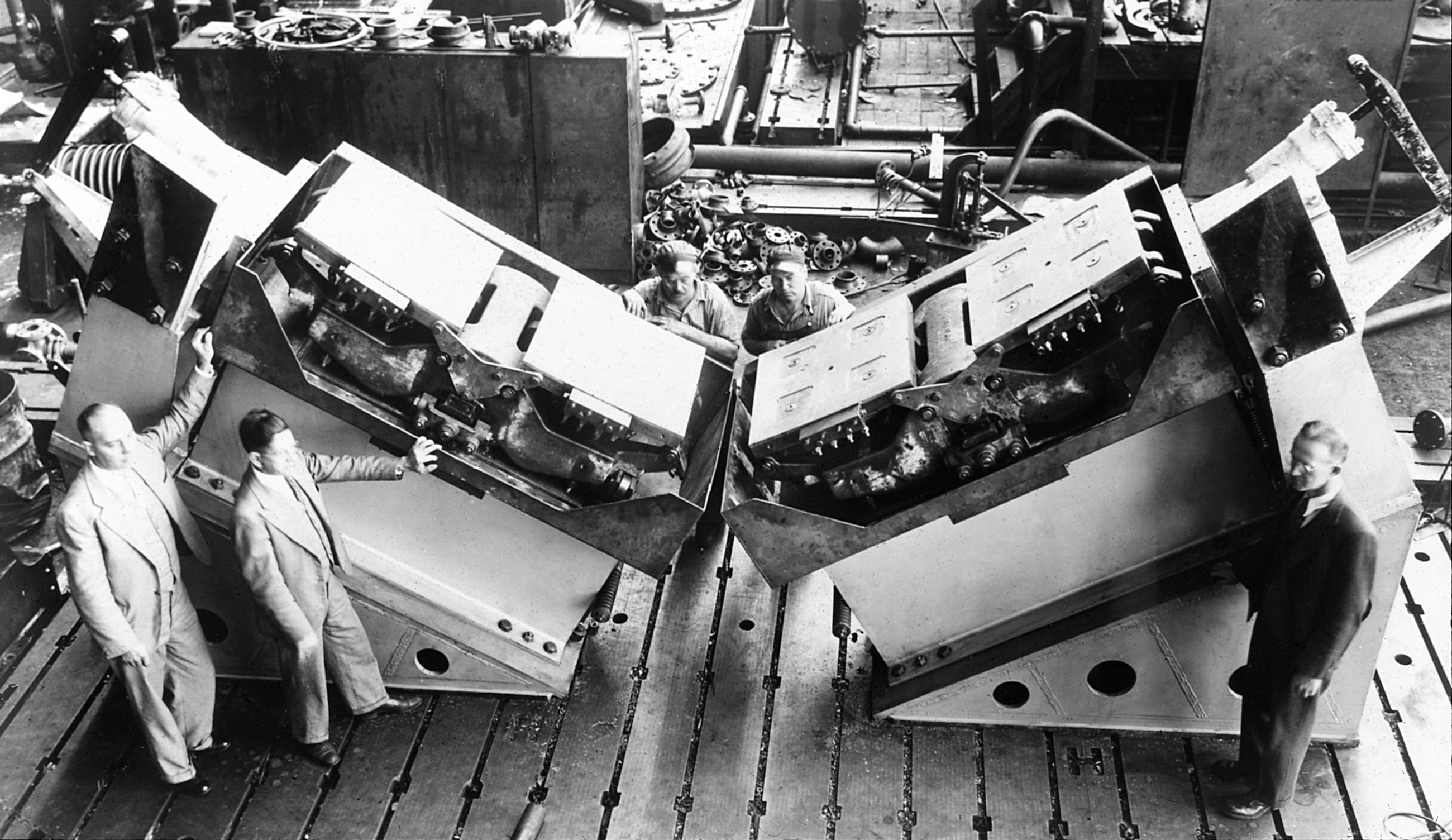

The telescope fixed mount has never moved a significant amount in its history, even with seismic events. But the telescope right ascension yoke and tube typically do move relative to the fixed mount as a result of seismic events, and the telescope mount design and control system can accommodate these motions (e.g., as clutch system slip and zero-point changes).
About four minutes.
Although the lighting gives it the look of copper, the inside wall of the dome is made of aluminum.
Adaptive optics systems sense and compensate for distortions caused by Earth’s atmosphere—known as seeing, what makes stars twinkle—to deliver sharp images comparable to those produced by space telescopes from a ground-based facility.
PALM-3000 is the adaptive optics system for the Hale Telescope. The heart of the system is a deformable mirror with 3388 actuators that rapidly change the mirror shape. The reflective surface is adjusted in real-time, up to 2000 times a second, to correct for atmospheric distortions and refocus starlight into sharp images. PALM-3000 brings the optical power of the Hale Telescope closer to its diffraction limit by producing images typically 10–20 times sharper than seeing-limited instruments.
The animated image below shows an adaptive optics schematic.
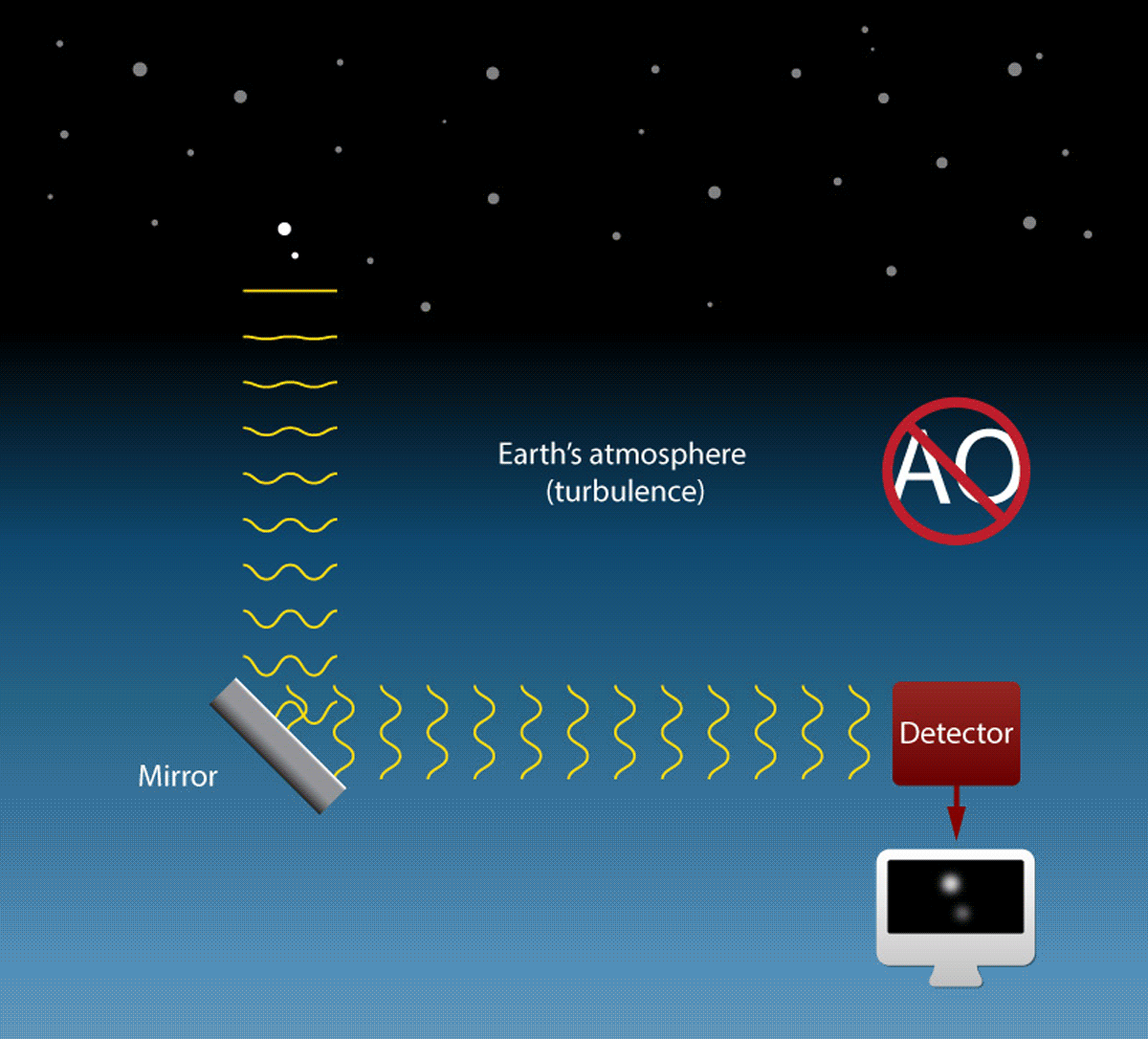
In addition to the Hale, there are two other telescopes at Palomar Observatory: the 48-inch Samuel Oschin Telescope and the 60-inch telescope.
The Samuel Oschin Telescope is one of the most productive survey telescopes ever built with a dozen completed surveys since the 1950s. The wide-field imaging capabilities of this telescope (it has a usable field hundreds of times larger than that of the 200-inch Hale Telescope, see question 9 above) makes it ideal for conducting systematic surveys of the sky. In recent years, the Samuel Oschin Telescope has been used to scan large regions of the sky to search for transient events—objects that change apparent brightness and/or position—such as fast-moving Solar System objects, variable/pulsating stars, flares, novae, supernovae, gamma-ray bursts and other stellar explosions. It currently operates robotically, scanning the skies nightly and returning a wealth of astronomical data.
The 60-inch telescope was built to take some of the demand off of the 200-inch Hale Telescope. Like the Samuel Oschin Telescope, the 60-inch also operates robotically. In addition to being used for follow-up observations of potentially interesting astronomical phenomena first detected by sky surveys or by other telescopes, the 60-inch is a platform for testing new instrument technology.
While these telescopes aren’t open to the public, you may use the VR Tour in this guide to “virtually visit” these locations.
LAUNCH VIRTUAL TOURAccess to Palomar telescopes is based on your standing with a Palomar project or partner constituency (e.g., Caltech, JPL, NAOC, and Yale). Visit the observer FAQ page for more on the the telescope time application process.
APPLYING FOR TELESCOPE TIMEThe Hartmann screen was used in the final polishing procedures for the mirror between 1947 and 1949 after it had arrived at Palomar from the Caltech campus. Glass reflects about 6% of the incident light even without an aluminum coating. During polishing, the screen was placed at the top of the telescope and a picture was taken of the light pattern. Because the light pattern of the image should correspond precisely to the hole pattern on the Hartmann screen the opticians working on the mirror could tell where any irregularities were on the mirror surface and work to correct them.
The observatory is looking for individuals who are interested in joining our docent group. A candidate does not need to be an astronomer or an expert on the subject of Palomar Observatory to apply. A willingness to learn and to work with observatory visitors is all that is needed. Applicants chosen for the docent program will receive all the training they will need: including information on the current research and history of the Palomar Observatory, basic astronomy, working with the public and more. Selected docents may be invited to occasional evening visits at the observatory as a part of their training, giving them the opportunity to see Palomar's telescopes and astronomers in action. Read more on how to become a docent below.
PALOMAR DOCENTSThe Friends of Palomar Observatory offers you an unique opportunity to connect to the active research mission and scientists of the observatory. As a Friend you will:
Please refer to our Friends page for more information and application form.
FRIENDS OF PALOMARThe heart of the Palomar Observatory community is its staff—a team of administrative, technical, maintenance, service, and telescope support professionals that ensure smooth day-to-day operations and effective instrument performance. Roughly two dozen staff live and/or work at the observatory. Please check the Caltech Human Resources jobs postings page regularly for employment listings (select Palomar as location).
CALTECH JOB POSTINGSNo—Palomar Observatory is owned and operated by Caltech (the California Institute of Technology).
About 2,000 acres.
George Ellery Hale, chairman of the Observatory Committee, wanted the telescope to be located: (1) within a day’s drive of the offices in Pasadena; (2) on a mountain that faced the Pacific Ocean; and (3) in a relatively quiet seismic zone. After six years of study and testing, the Observatory Committee found that seeing conditions on Palomar Mountain were comparable to conditions found on other mountains in the area.
Palomar Observatory is roughly 5600 ft above sea level.
Yes—recently we upgraded the Gift and Book Store's online portal. There you can find official Palomar Observatory merchandise and products for the astronomy/space enthusiast in your life. Shop comfortably and securely with us 24/7 at store.palomar.caltech.edu.
ONLINE STOREYes, there are a number of excellent books dedicated to various aspects of the observatory's history and science. The following is a short list of our main go-to sources. Keep in mind that this is not an exhaustive list, and specific details on Palomar science and engineering may be better addressed in contemporary sources such as scientific publications or popular magazine articles—Caltech E&S, Life Magazine, Popular Science, Scientific American to name a few.
Unfortunately no—we have a few webcams online on our website but none show the view through the telescope.
We do not answer general astronomy questions. Here are a few links that may help:
ASK AN ASTRONOMER (1) ASK AN ASTRONOMER (2) TONIGHT LIGHTS IN THE SKY